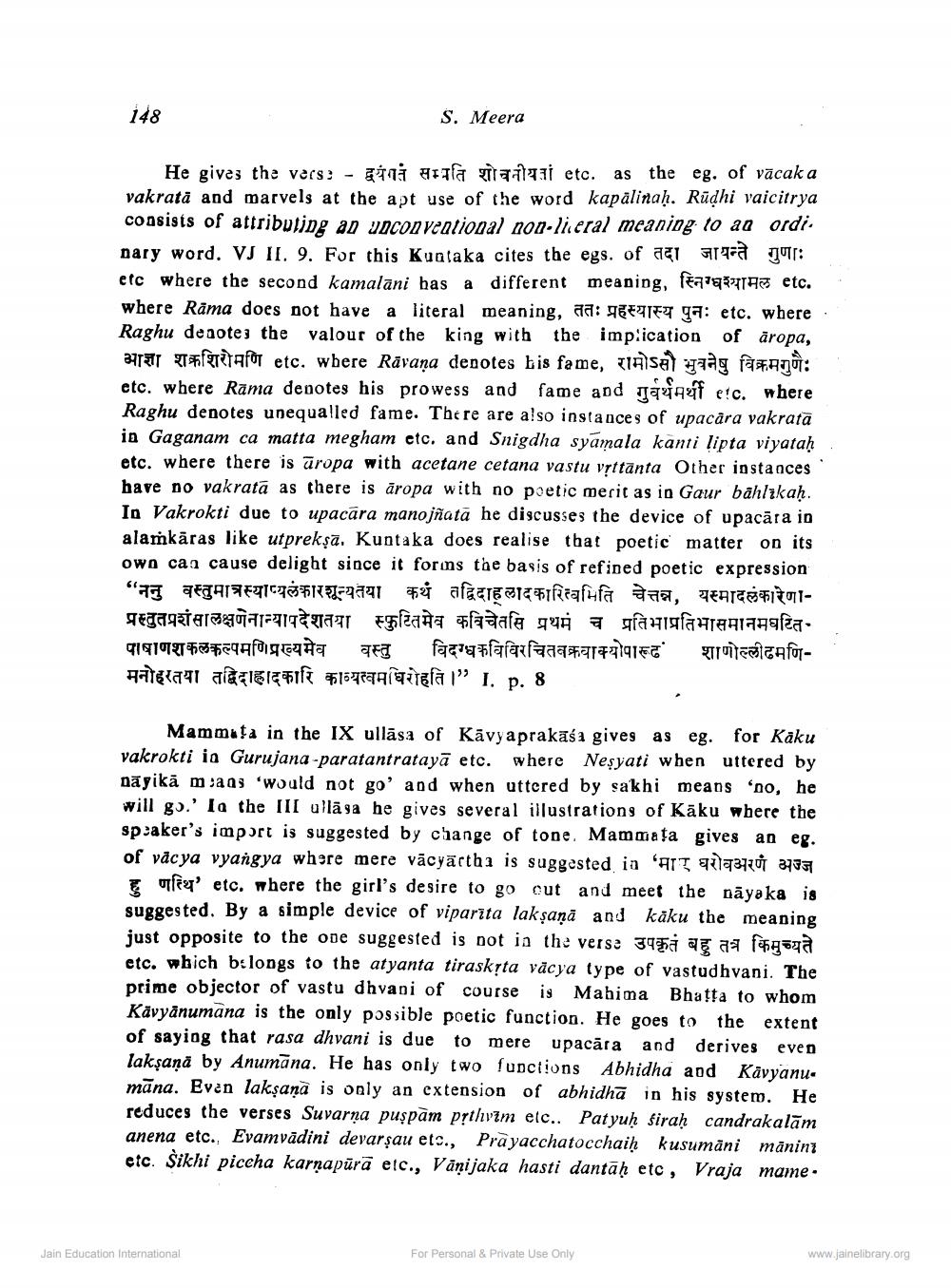________________
148
S. Meera
He gives the vers: - to fa ga etc. as the eg, of vācak a vakrata and marvels at the apt use of the word kapalinaḥ. Rūdhi vaicitrya consists of attributing an unconventional non-li eral meaning to an ordi. nary word. VS II. 9. For this Kuntaka cites the egs. of aci 719 JT: etc where the second kamalani has a different meaning, fala etc. where Rama does not have a literal meaning, aa: 9&FIFT ga: etc. where Raghu denotes the valour of the king with the implication of aropa,
आज्ञा शक्रशिरोमणि etc. where Ravana denotes his fame, रामोऽसौ भुवनेषु विक्रमगुणैः etc. where Rama denotes his prowess and fame and garraf etc. where Raghu denotes unequalled fame. There are also instances of upacara vakratā in Gaganam ca matta megham etc. and Snigdha syamala kanti lipta viyataḥ etc. where there is ūropa with acetane cetana vastu vyttänta Other instances have no vakratā as there is āropa with no poetic merit as in Gaur bahlakaḥ. In Vakrokti due to upacara manojñatā he discusses the device of upacāra in alamkāras like utprekşā. Kuntaka does realise that poetic matter on its own can cause delight since it forms the basis of refined poetic expression "ननु वस्तुमात्रस्याप्यलंकारशून्यतया कथं तद्विदाहलादकारित्वमिति चेत्तन्न, यस्मादलंकारेणाप्रस्तुतप्रशंसालक्षणेनान्यापदेशतया स्फुटितमेव कविचेतसि प्रथमं च प्रतिभाप्रतिभासमानमघटित. पाषाणशकलकल्पमणिप्रख्यमेव वस्तु विदग्धकविविरचितवक्रवाक्योपारूढ शाणोल्लीढमणिHaigla Telif #16769itafa ” I. p. 8
Mammuta in the IX ullāsa of Kavya prakāśa gives as eg. for Kaku vakrokti ia Gurujana-paratantratayā etc. where Neşyati when uttered by nāyikā mans would not go and when uttered by sakhi means 'no, he will go.' la the III ullā sa he gives several illustrations of Kāku where the speaker's import is suggested by change of tone. Mammața gives an eg. of vācya vyangya where mere vācyārtha is suggested in 'मार घरोवअरणं अज्ज
ofeet' etc. where the girl's desire to go out and meet the nāyaka is suggested. By a simple device of viparīta lakşaņā and kāku the meaning just opposite to the one suggested is not in the verse उपकृतं बहु तत्र किमुच्यते etc. which b:longs to the atyanta tiraskyta väcya type of vastudhvani. The prime objector of vastu dhvani of course is Mahima Bhatta to whom Kävyänumana is the only possible poetic function. He goes to the extent of saying that rasa dhvani is due to mere upacara and derives even lakşană by Anumāna. He has only two functions Abhidha aod Kavyanu. māna. Even laksana is only an extension of abhidhā in his system. He reduces the verses Suvarna pușpām přthvīm etc.. Patyuḥ sirah candrakalām anena etc. Evamvādini devarşau eto., Prayacchatocchaiḥ kusumäni mānini etc. Șikhi piccha karnapūrā etc., Vānijaka hasti dantāḥ etc, Vraja mame.
Jain Education International
For Personal & Private Use Only
www.jainelibrary.org




